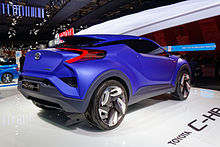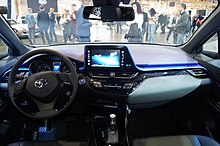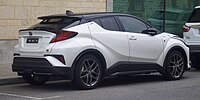The Toyota C-HR (Japanese: トヨタ C-HR, Hepburn: Toyota Shīeichiāru) is a subcompact crossover SUV manufactured and marketed by Japanese automaker Toyota since 2016. The development of the car began in 2013, led by Toyota chief engineer Hiroyuki Koba,[3] sharing the TNGA-C (GA-C) platform with the E210 series Corolla[4][5] and positioned between the Yaris Cross and Corolla Cross in Toyota's crossover SUV range.
| Toyota C-HR | |
|---|---|
 2024 Toyota C-HR GR Sport Hybrid | |
| Overview | |
| Manufacturer | Toyota |
| Also called | Toyota IZOA (FAW Toyota; China)[1] |
| Production | 2016–present |
| Body and chassis | |
| Class | Subcompact crossover SUV |
| Body style | 5-door SUV |
| Layout | |
| Platform | TNGA: GA-C[2] |
First generation (AX10/AX50; 2016)
| First generation | |
|---|---|
 C-HR (pre-facelift) | |
| Overview | |
| Model code |
|
| Also called |
|
| Production | November 2016 – September 2023 |
| Model years | 2018–2022 (North America) |
| Assembly |
|
| Designer | Ian Cartabiano, Katsuhiro Suzuki and Kazuhiro Sato[6] |
| Body and chassis | |
| Layout | |
| Related | |
| Powertrain | |
| Engine |
|
| Electric motor | 150 kW (201 hp; 204 PS) 4KM synchronous (C-HR/IZOA EV) |
| Transmission | |
| Hybrid drivetrain | Power-split hybrid (C-HR Hybrid) |
| Battery |
|
| Plug-in charging | 6.6 kW AC, 50 kW DC (C-HR/IZOA EV) |
| Dimensions | |
| Wheelbase | 2,640 mm (103.9 in) |
| Length | 4,360–4,385 mm (171.7–172.6 in) |
| Width | 1,795 mm (70.7 in) |
| Height | 1,565 mm (61.6 in) |
| Curb weight | 1,380–1,460 kg (3,042–3,219 lb) |
Concept model
The Toyota C-HR was first previewed by the Scion C-HR Concept, and then the Toyota C-HR Concept.
- Toyota C-HR Concept
- Toyota C-HR Concept
Production model
The production version of the C-HR was unveiled at the March 2016 Geneva Motor Show and started production in November 2016. It was launched in Japan on 14 December 2016.[7] It went on sale in Europe, Australia, South Africa and North America in early 2017, and in Southeast Asia, China and Taiwan in 2018. The name C-HR can stand for either Compact High Rider,[7] Cross Hatch Run–about[7] or Coupe High Rider.[8]
Initial production was in Japan and Turkey. The 2018–2020 model year North American-spec C-HR is imported from Turkey.[9]
- Rear view (pre-facelift)
- 2017 C-HR 1.8 Hybrid (pre-facelift)
- 2017 C-HR 1.8 Hybrid (pre-facelift)
- Interior
Japan
In Japan, the C-HR is sold at all Toyota dealership sales channels (Toyota Store, Toyopet Store, Toyota Corolla Store and Netz Store). The Japanese market C-HR is powered by either 1.2-litre turbocharged petrol engine, or 1.8-litre Hybrid. The FWD models are available with both engines, while the only engine for the AWD models is the 1.2-litre turbo. Model grades are S, S-LED, G, S-T and G-T. Models S, S-LED, G are powered with a 1.2-litre turbo engine, while other models by a 1.8-litre Hybrid. LED Package is exclusive for the G and S-LED packages.
Asia
The Thai-built C-HR with 1.8-litre 2ZR-FBE or 2ZR-FE engine is sold in certain Asian countries such as Thailand, Indonesia, Malaysia and Brunei. The ASEAN production version was unveiled in Thailand on 30 November 2017, at the 34th Thailand International Motor Expo.[citation needed]
For the Indonesian market, the C-HR was launched on 10 April 2018, initially with a 1.8-litre 2ZR-FE petrol engine. The hybrid variant followed later on 22 April 2019. The petrol variant was discontinued in March 2022. The remaining sole hybrid variant received Toyota Safety Sense on 27 May 2022 and sold until May 2023.[citation needed]
In Brunei, the C-HR was launched in early 2018 and offered in the mid and high grade models with a petrol engine, and a hybrid model. It was discontinued in 2022.[citation needed]
For Taiwan, the C-HR is only offered with 1.2-litre 8NR-FTS petrol engine. Buyers in Taiwan can choose the FWD and AWD models.[citation needed]
In Singapore, it received the FWD model in Active and Luxury grades by the local distributor with the 1.2-litre engine while hybrid 1.8-litre models are offered by parallel importers.[citation needed]
For the Chinese market, the C-HR is sold by GAC Toyota, while its twin model sold by FAW Toyota is called the IZOA (Chinese: 奕泽; pinyin: Yìzé). The IZOA features a front bumper grille with horizontal lines instead of mesh on the C-HR. Both the C-HR and IZOA were revealed at the Auto Guangzhou in November 2017 and went on sale in April 2018. The electric vehicle (EV) variant of both the C-HR and IZOA were unveiled at the 18th Auto Shanghai on 16 April 2019, as the first battery electric vehicle in Toyota's upcoming lineup.[10]
The C-HR EV went on sale in China in April 2020. The electric motor produces 150 kW (201 hp; 204 PS) and 300 N⋅m (220 lb⋅ft) of torque. The 54.3 kWh lithium-ion battery pack is claimed to deliver a range of up to 400 km (250 miles) as per NEDC.[11]
In late 2020, the comparatively expensive (being a fully imported model from Thailand) C-HR was discontinued in Malaysia, leading to declining sales. It was replaced by the Corolla Cross, launched in late March 2021.[12]
Europe
As in Japan, the C-HR for Europe can be purchased with either 1.2-litre turbocharged petrol, a 1.8-litre hybrid or with 2.0-litre hybrid. 6-speed manual transmission is only installed in the front-wheel-drive 1.2-litre turbo; the sole gearbox for the 1.2-litre turbo AWD and the hybrid is a CVT.
Trim levels vary across countries. In the UK, they are Icon, Design, Excel and Dynamic. For the French market, there are even more marketing name variations such as Active, Dynamic, Edition, Graphic, Distinctive and Collection. In Romania there are C-enter, C-ult Style and C-lassy. They are essentially similar cars with different standard or optional equipment.
Australia
For the Australian market (imported from Japan), the C-HR is only offered with the 1.2-litre, 8NR-FTS turbo motor. The base model is available in manual transmission as a FWD only, automatic transmission models may be FWD or AWD. The high level Koba model is available in both FWD and AWD variants. The gearbox for the base model is a choice of 6-speed manual transmission or CVT with 7-speed simulated gear. The Koba comes with CVT only, and is equipped with LED headlights, leather seats, heated front seats, and smart entry and start system.[13]
North America
Unique for the North American C-HR is the larger 2.0-litre 3ZR-FAE naturally aspirated petrol engine which is matched to a CVT gearbox. In North America, the C-HR was originally planned to be marketed under the Scion brand, before Toyota discontinued the marque.[14][15] The 2018 model year was only available in either the XLE or XLE Premium model.[16] For the 2019 model year, the C-HR is available in LE, XLE, XLE Premium or Limited models.[17]
The C-HR was discontinued in North America after the 2022 model year,[18] where Toyota elected not to market the subsequent, second-generation C-HR, and the Corolla Cross continued as the brand's subcompact crossover/SUV.[19]
Facelift
The facelifted C-HR was unveiled in Japan, Europe, Australia, and North America in October 2019. The European model received the 2.0-litre M20A-FXS hybrid engine option for the first time. Android Auto and Apple CarPlay became standard. The GR Sport variant is also offered.[20][21]
- 2020 Toyota C-HR Hybrid
- 2020 Toyota C-HR Hybrid (facelift)
- 2020 C-HR Design Hybrid (facelift)
- 2020 C-HR Design Hybrid (facelift)
- C-HR GR Sport Hybrid (facelift)
- C-HR GR Sport Hybrid (facelift)
- GAC Toyota C-HR EV (China)
IZOA
- FAW Toyota IZOA (pre-facelift, China)
- IZOA Hybrid (facelift, China)
- IZOA EV (China)
Safety
Euro NCAP
ASEAN NCAP
| ASEAN NCAP scores[23] | |
| Overall stars | |
| Adult occupant | 35.80/36.00 |
| Child occupant | 40.89/49.00 |
| Safety assist | 14.92/18.00 |
Second generation (AX20; 2023)
| Second generation | |
|---|---|
 2024 C-HR GR Sport (Europe) | |
| Overview | |
| Model code | AX20 |
| Production | October 2023 – present[24] |
| Assembly | |
| Designer | Elvio D'Aprile, Ken Nagasaka[25] |
| Body and chassis | |
| Platform | TNGA: GA-C |
| Related | |
| Powertrain | |
| Engine | |
| Transmission | |
| Hybrid drivetrain | |
| Battery | 4.08Ah lithium-ion |
| Dimensions | |
| Wheelbase | 2,640 mm (103.9 in) |
| Length | 4,360 mm (171.7 in) |
| Width | 1,830 mm (72.0 in) |
| Height | 1,538–1,564 mm (60.6–61.6 in) |
The second generation was previewed by a concept called the ‘Toyota C-HR Prologue’ on 6 December 2022.[26]
The second iteration of the C-HR was revealed on 26 June 2023, and officially launched in October 2023. It receives two-tone paint, with a sharper, sleeker body compared to the previous model.[27][28] The C-HR now features the new design language of Toyota, with C-shaped headlights that can be found on the Prius XW60 and the Aygo X Concept. Based on the previous model, it features similar features from it such as its hatchback body style, its platform, and similar models. Now exclusively on a hybrid drivetrain, it introduces a plug-in hybrid option for the first time, though the PHEV will not be sold in Australia.[29]
With the same wheelbase as the previous model, the base models receive a 8.0-inch console display with higher end models including a dual 12.3-inch infotainment screen. The C-HR receives an upgrade in technology compared to the previous model, including a digital key, advanced safety systems, a remote parking option, and a hands-free driving system in traffic jams.[30]
The new C-HR will no longer be built in Japan, instead it will be built exclusively in Turkey, at Toyota's Turkish plant.[26] This generation will not be sold in North America, but will be replaced with the Corolla Cross, which is a C-segment vehicle about 100 mm (3.9 in) longer.[31]
The C-HR GR Sport features 20-inch wheels with a all-wheel drive system using the brand's E-four 4WD system. It has 2 electric motors with a power output of 145 kW (194 hp).
- Rear view
- Interior
Markets
Australia
The second-generation C-HR will go on sale in H1 2023, exclusively in hybrid, excluding the PHEV.[32] Trims included are GXL, Koba and GR Sport in 1.8 L and 2.0 L form.[33]
Europe
The C-HR is expected within 2024 with all variants including 1.8 litre and 2.0 litre hybrids and 2.0 litre plug-in hybrids.[34]
Powertrain
The powertrain of the second iteration C-HR hatchback consists of three models: a 1.8 L hybrid version using the 2ZR-FXE with a combined power output of 103 kW (138 hp; 140 PS) using the single motor and the engine, a 2.0 L hybrid version using the M20A-FXS engine, with a combined output of 145 kW (194 hp; 197 PS) using the engine and the motors, and a plug-in hybrid variant using the M20A-FXS engine, producing a combined output of 164 kW (220 hp; 223 PS) with the engine and motors.
All models use the eCVT transmission.
| Engines[35][29][28] | |||||||||||||
|---|---|---|---|---|---|---|---|---|---|---|---|---|---|
Spec Type |
Engine code | Displacement | Power | Torque | Combined system output | Electric motor | Battery | Transmission | Top speed | 0–100 km/h (0–62 mph) | Electric range | Layout | Cal. years |
| Petrol hybrid | 2ZR-FXE | 1,798 cc (1.8 L) I4 | Engine: 72 kW (97 hp; 98 PS) at 5,200
Front motor: 70 kW (94 hp; 95 PS) |
Engine: 142 N⋅m (14.5 kg⋅m; 105 lb⋅ft) at 3,600
Front motor: 185 N⋅m (18.9 kg⋅m; 136 lb⋅ft) |
103 kW (138 hp; 140 PS) | - | 4.08 Ah lithium-ion | eCVT | 170 km/h (110 mph) | 9.9 s | - | FWD | |
| 2023— | |||||||||||||
| Petrol hybrid | M20A-FXS | 1,986 cc (2.0 L) I4 | Engine: 112 kW (150 hp; 152 PS) at 6,000
Front motor: 83 kW (111 hp; 113 PS) Rear motor: 30 kW (40 hp; 41 PS) |
190 N⋅m (19.4 kg⋅m; 140 lb⋅ft) at 4,400-5,200
Front motor: 206 N⋅m (21.0 kg⋅m; 152 lb⋅ft) Rear motor: 84 N⋅m (8.57 kg⋅m; 62.0 lb⋅ft) |
145 kW (194 hp; 197 PS) | - | 4.08 Ah lithium-ion | eCVT | 180 km/h (110 mph) | 8.1 s (FWD) 7.9 s (AWD) |
- | FWD AWD (AWD-i) | |
| 2023— | |||||||||||||
| Petrol plug-in hybrid | M20A-FXS | 1,986 cc (2.0 L) I4 | TBA | TBA | 164 kW (220 hp; 223 PS) | - | - | eCVT | 180 km/h (110 mph) | 7.4 s | 66 km (41 mi) | FWD | |
| 2023— | |||||||||||||
Safety
Sales
| Year | Europe[37] | Turkey[38] | U.S.[39] | Mexico[40] | Japan[41] | Thailand | China | |
|---|---|---|---|---|---|---|---|---|
| C-HR[42] | IZOA[43] | |||||||
| 2016 | 7,123 | 1,719 | 4,654 | |||||
| 2017 | 108,170 | 6,278 | 25,755 | 117,299 | ||||
| 2018 | 131,348 | 3,691 | 49,642 | 3,504 | 76,756 | 15,930[44] | 22,720 | 29,080 |
| 2019 | 119,786 | 2,866 | 48,930 | 2,629 | 55,677 | 13,318[45] | 59,461 | 52,989 |
| 2020 | 101,252 | 3,984 | 42,936 | 1,721 | 33,676 | 3,381[46] | 55,246 | 45,554 |
| 2021 | 106,251 | 2,281 | 35,707 | 18,096 | 1,729[47] | 46,433 | 44,803 | |
| 2022 | 109,543[48] | 1,561 | 12,141 | 11,811 | 1,441[49] | |||
| 2023 | 117,552[50] | 2,775 | 9,810 | 590[51] | ||||
References
External links
Wikiwand in your browser!
Seamless Wikipedia browsing. On steroids.
Every time you click a link to Wikipedia, Wiktionary or Wikiquote in your browser's search results, it will show the modern Wikiwand interface.
Wikiwand extension is a five stars, simple, with minimum permission required to keep your browsing private, safe and transparent.


















